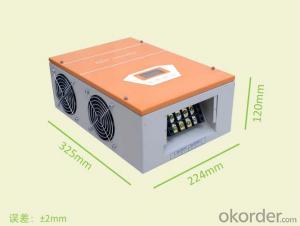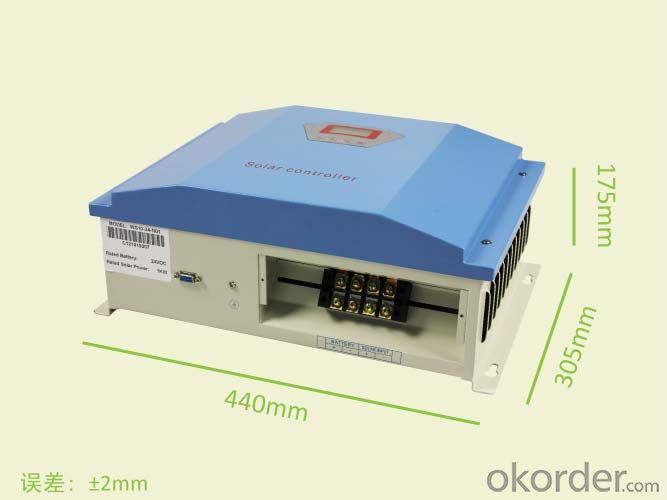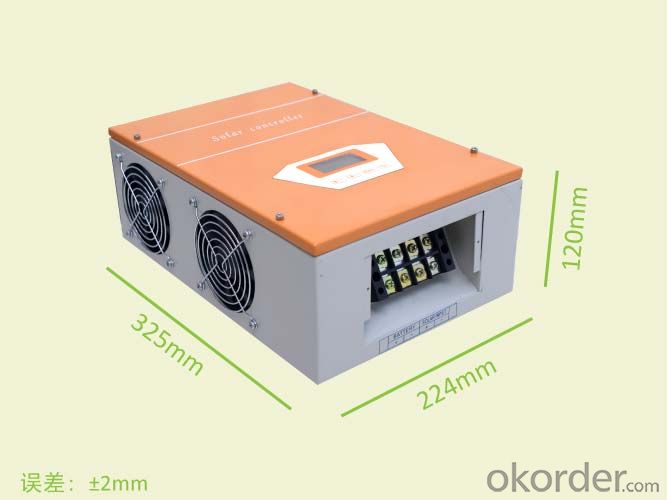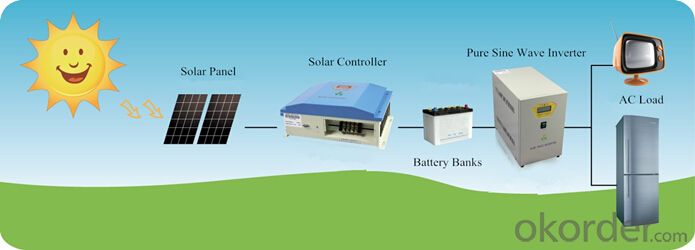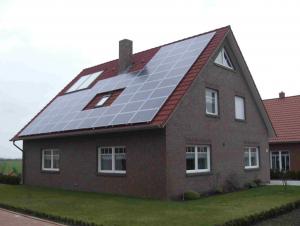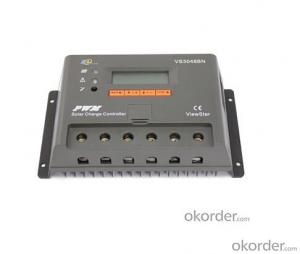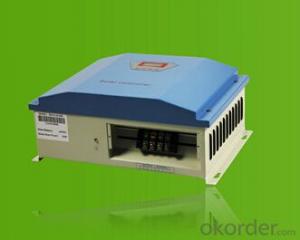Water Resistant Solar Charge Controller 2KW MPPT Charging Function
- Loading Port:
- Shanghai
- Payment Terms:
- TT or LC
- Min Order Qty:
- 1 unit
- Supply Capability:
- 10000 unit/month
OKorder Service Pledge
OKorder Financial Service
You Might Also Like
I. PRODUCT INTRODUCTION
Solar controller is control device which can control solar panel and transform solar energy into electricity then store to the battery bank. Solar controller is the most important part in off-grid system, whose performance has much effect on life expectancy and operation of the whole system, especially the battery expectancy. Or battery service life will be shortened by over charge or over discharge.
II. PERFORMANCE FEATURES
Superior military-grade components to ensure the product stability.
Perfect protection function, thus the system has higher reliability.
Check and set all operation parameters as requirement from LCD display.
PWM stepless unload mode, which burn the excess power into Dump load, making the battery charging in best status.
III. APPLICATION AREAS
Standalone Photovoltaic power station
Standalone Domestic household photovoltaic power system
Mobil communication base stations, expressway and other non-residential regions.
Coastal islands, remote mountainous, border posts for regions shortage of or without electricity.
Government demonstration projects, landscape lighting project etc.
IV. 2KW TECHNICAL PARAMETERS
Product model | WS20-48-N00 | WS20-96-N00 | WS20-110-N00 | WS20-120-N00 | WS20-220-N00 |
Rated battery power | 48V | 96V | 110V | 120V | 220V |
Rated solar input power | 2kW | 2kW | 2kW | 2kW | 2kW |
Floating charge voltage | 58V | 116V | 133V | 145V | 266V |
Max Open Circuit Voltage | 100V | 200V | 230V | 250V | 458V |
Dimensions (L x W x H) | 442×307×172 mm | ||||
Net weight | 7kg | ||||
Display mode | LCD | ||||
Cooling | Fan | ||||
Protection level | IP20(Indoor) | ||||
Quiescent current | ≤20 mA | ||||
Protection functions | Battery over charge; battery anti-reverse-connection; solar reverse charge protection; solar anti-reverse-connection; lightning protection. | ||||
Ambient temperature | -20~+55℃ | ||||
Ambient humidity | 0~93%, without condensing | ||||
Working altitude | ≤4000m | ||||
In order to serve our customers better, our company can adjust parameter configuration according to customer’s requirement. | |||||
- Q: How does a solar controller prevent reverse current flow from the battery to the solar panels?
- A solar controller prevents reverse current flow from the battery to the solar panels by incorporating a blocking diode in its circuitry. This diode acts as a one-way valve, allowing current to flow from the solar panels to the battery but blocking any reverse flow. As a result, the battery remains protected and the solar panels are not damaged by the battery's discharge.
- Q: What is the input voltage range of a solar controller?
- The input voltage range of a solar controller typically depends on the specific model and design, but it is commonly between 12V and 48V.
- Q: Can a solar controller be used with a solar-powered electric vehicle charging station for public use?
- Yes, a solar controller can be used with a solar-powered electric vehicle charging station for public use. A solar controller helps regulate the flow of electricity from the solar panels to the charging station, ensuring efficient charging and protecting the batteries from overcharging. It also allows for monitoring and control of the charging station's performance.
- Q: How does a solar controller prevent undercharging of batteries?
- A solar controller prevents undercharging of batteries by regulating the amount of charge that is delivered from the solar panels to the batteries. It monitors the battery's voltage and temperature, and adjusts the charging process accordingly to ensure that the batteries receive the optimal amount of charge without overcharging or undercharging.
- Q: Can a solar controller be used in a solar-powered medical equipment system?
- Yes, a solar controller can be used in a solar-powered medical equipment system. A solar controller is responsible for regulating the flow of electricity from the solar panels to the medical equipment, ensuring that the system functions efficiently and safely. It helps prevent overcharging, controls voltage levels, and protects the equipment from power surges. Therefore, incorporating a solar controller is essential for the successful operation of a solar-powered medical equipment system.
- Q: Can a solar controller be used with solar-powered indoor healthcare institutions?
- Solar-powered indoor healthcare institutions can benefit greatly from the use of a solar controller. This crucial component of a solar power system plays a vital role in regulating the charging and discharging of batteries and controlling the flow of electricity from the solar panels to connected devices or appliances. In the case of these healthcare institutions, the solar controller would be instrumental in efficiently charging the batteries that power the institution's electrical systems. It would also prevent damage and reduce the lifespan of the batteries by preventing overcharging. Furthermore, the solar controller can effectively manage the flow of electricity during periods of low sunlight or high demand. It can prioritize the use of solar energy for critical healthcare equipment and systems, ensuring a continuous power supply even on cloudy days or during power outages. By utilizing a solar controller, solar-powered indoor healthcare institutions can effectively harness and optimize the energy generated from solar panels. This not only reduces their reliance on traditional power sources but also lowers operational costs. Additionally, solar power is a clean and renewable energy source, aligning with the principles of sustainability and environmental responsibility commonly associated with healthcare institutions. In conclusion, the solar controller is an essential component for solar-powered indoor healthcare institutions. Its role in regulating and optimizing the use of solar energy ensures a reliable and sustainable power supply to critical healthcare equipment and systems.
- Q: Can a solar controller be used in a hybrid solar panel system?
- Yes, a solar controller can be used in a hybrid solar panel system. A solar controller, also known as a charge controller, is responsible for regulating the voltage and current from the solar panels to the batteries or grid. In a hybrid solar panel system, which combines both solar and other energy sources like wind or grid electricity, a solar controller is still necessary to manage the charge from the solar panels. It helps ensure that the batteries are properly charged and protected from overcharging or excessive discharging. Additionally, a solar controller can also monitor and optimize the energy flow between the different energy sources in a hybrid system, maximizing the efficiency and utilization of the solar power generated.
- Q: Can a solar controller be used with solar-powered air conditioning systems?
- Yes, a solar controller can be used with solar-powered air conditioning systems. A solar controller is designed to regulate and optimize the charging and discharging of solar batteries. Since solar-powered air conditioning systems utilize solar energy to operate, a solar controller can effectively manage the flow of power to the air conditioning system, ensuring efficient and reliable performance.
- Q: What is the maximum input power for a solar controller?
- The maximum input power for a solar controller depends on its specifications and can vary. Typically, it ranges from 100 to 500 watts, but higher-end controllers can handle even greater input power.
- Q: Can a solar controller be used with different types of solar panel shading systems?
- Yes, a solar controller can be used with different types of solar panel shading systems. The main function of a solar controller is to regulate the flow of electricity between the solar panels and the battery or grid. It does not specifically depend on the type of solar panel shading system being used. Whether you have a fixed tilt, single-axis, or dual-axis solar panel shading system, a solar controller can still be utilized to optimize the energy generation and protect the batteries from overcharging. However, it is important to ensure that the solar controller is compatible with the specific voltage and current requirements of your solar panel system.
Send your message to us
Water Resistant Solar Charge Controller 2KW MPPT Charging Function
- Loading Port:
- Shanghai
- Payment Terms:
- TT or LC
- Min Order Qty:
- 1 unit
- Supply Capability:
- 10000 unit/month
OKorder Service Pledge
OKorder Financial Service
Similar products
Hot products
Hot Searches
Related keywords

